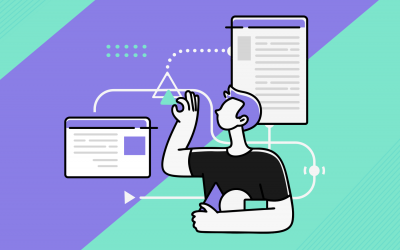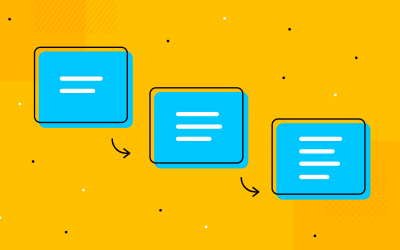Data-driven design at Yelp: Q&A with Product Designer Taron Ghazaryan

Data-driven design, delightful micro-interactions and what makes the perfect prototyping tool. Yelp’s Product Designer talks to Justinmind
Want to know where to get the best taco in any and every State? Or reserve a date with a rockabilly hairstylist in your neighbourhood? Or just get some of those tacos delivered? Then you need Yelp. The San Fran-based app and website connects people worldwide with the best local businesses in their area, based on data from over 115 million user-generated reviews.
Yelp also invents new ways for businesses to connect to their local community, providing training in how to respond to reviews and organizing social events for reviewers.
Behind Yelp’s comfortably local vibe lies a ton of data-driven, user-centric design. Product Designer Taron Ghazaryan is one of the guys in charge of making Yelp delightful for users, building user-generated content into positive user experiences and intuitive user interfaces.
The Justinmind team were curious to find out what life is like in the Yelp Product and Design team, and how Taron tackles the challenges of building Yelp into “a companion for just about anything local.”
Can you describe your average day as Product Designer at Yelp?
We like to start our day with a visual standup in a Slack design channel. It keeps everyone in the know-how of ongoing projects and is also nice eye candy to get our creative juices flowing. Every designer here works differently and we encourage that freedom, making everyone’s average day a little different.
The Yelp interface conceals a lot of behind-the-scenes data-crunching. What are some of the challenges you face in building intuitive user interfaces that condense complexity and promote intuitiveness?
Our engineering team does a great job in structuring data, which makes the presentation of it relatively easy. The bigger challenge for me is anticipating user-generated content and trying to design a solution that can work with everything.
For example, a review can be short, long, have photos, be in Japanese, or be from an Elite user, etc. Creating a flexible design to fit these criteria can sometimes be difficult.
What’s the role of prototyping in good Product Design? And what do you as a Product Designer look for in a prototyping tool?
Prototyping is an essential step in our process. Given the dynamic nature of apps and sites, static design mocks don’t communicate the experience as well as a prototype. The perfect prototyping tool is one that allows me to iterate through ideas quickly and easily.
Having to stop and figure out why your code is crashing halts the creative process. Not knowing how to do something will also change the outcome of the final product as you’ll look for alternate interactions.
Can you give us an example of a time a prototype helped Yelp solve a tricky situation or design something really cool?
I love prototyping subtle micro-interactions that may be noticeable only if you look for them. Delighting the user with an array of these almost hidden, but helpful interactions makes the overall experience feel more polished.
For example, we’re moving towards a design language of large photos on top of scrollable pages in mobile. We’d also like to retain all of the platform paradigms that users are accustomed to. A prototype helped us visualize the transition between an image and a navigation bar and enabled us to iron out any bumps before showing developers.
Yelp’s mobile traffic is growing – what challenges and opportunities has that created for you as Product Designer?
Our understanding of how people use Yelp on the go is constantly changing. The apps are no longer about just helping you find that great local business, but being a companion for just about anything local.
A prototype helped us visualize the transition between an image and a navigation bar and enabled us to iron out any bumps before showing developers.
The number of sensors and data that is offered on mobile devices presents opportunities for us to be that useful companion. Sometimes the feature we design may not even have an interface, but still improve the user experience tremendously.
What’s the UX and Design culture like at Yelp? How is the team organized and what inspires you guys?
The design team is a tight-knit group of some of the most creative people I’ve worked with. We critique each other’s work and try to improve ourselves constantly. While the product team is divided into feature teams, we designers sit in close proximity to each other for effortless ideation and feedback.
We use Slack to share inspiring work by other designers or companies, typically followed by praise and discussion.
How do you feel the design team has contributed to Yelp’s larger success?
Every project we kick off is accompanied by a goal that needs to be met. Sometimes the goals are simply to improve the user experience, resulting in higher overall app engagement and happiness. Other times the goals are to improve hard metrics, like the completion rate on a certain feature.
The design team’s impact on Yelp’s success can be directly measured by these projects.
How has working at Yelp changed you as a Product Designer?
Yelp’s complexity and scale has changed the way I approach projects. I no longer view pages or features individually, but as a part of a larger ecosystem that gets affected by my changes. I have to think about business goals, user needs, tech debt, style guide changes, scalability and other considerations when designing at Yelp.
Related Content
 Microcopy may be mini, but it can have a macro impact on user experience. Check out these 15 examples and start writing great UX microcopy16 min Read
Microcopy may be mini, but it can have a macro impact on user experience. Check out these 15 examples and start writing great UX microcopy16 min Read UX design has changed all of our lives forever - but what does it entail, exactly? What do designers do to create incredible products? Read on and find out!15 min Read
UX design has changed all of our lives forever - but what does it entail, exactly? What do designers do to create incredible products? Read on and find out!15 min Read Progressive disclosure is about helping users get invested before getting to the nitty gritty. Read this post to discover a new way to approach complex features!8 min Read
Progressive disclosure is about helping users get invested before getting to the nitty gritty. Read this post to discover a new way to approach complex features!8 min Read


